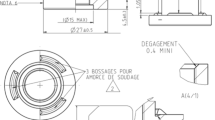Abstract
Due to its distinct production paradigm, additive manufacturing (AM) is positioned to bring about a revolution. It presents the possibility of on-demand, decentralized, and mass-customizable manufacturing. However, several issues related to design principles, standardization, and quality control arise from not only the complexity of production systems but also the need for increasingly complicated and high-quality goods. Artificial Intelligence (AI)-based algorithms, which can effectively monitor quality, optimize processes, model complex systems, and manage energy, is essential in addressing the difficulties. In the present work, we have used three supervised machine learning regression-based algorithms, i.e., XG Boost, Random Forest, and Decision Trees, to determine the Flexural Strength of the Fused Deposition Modeling specimen. The results showed that the XG Boost algorithm resulted in the highest coefficient of determination value of 0.77. Supervised machine learning classification-based algorithms such as the Stochastic Gradient Descent (SGD) algorithm, Decision Tree, and Random Forest algorithm is used to determine good and bad flexural strength specimens. The result showed that the SGD algorithm achieved the highest F1 score of 0.85.









Similar content being viewed by others

Data availability
Not applicable.
References
Dilberoglu UM, Gharehpapagh B, Yaman U, Dolen M (2017) The role of additive manufacturing in the era of industry 4.0. Proc Manuf 11:545–554. https://doi.org/10.1016/j.promfg.2017.07.148
Herzog D, Seyda V, Wycisk E, Emmelmann C (2016) Additive manufacturing of metals. Acta Mater 117:371–392. https://doi.org/10.1016/j.actamat.2016.07.019
Dörfler K et al (2022) Additive manufacturing using mobile robots: opportunities and challenges for building construction. Cement Concrete Res 158:106772. https://doi.org/10.1016/j.cemconres.2022.106772
Sefene EM (2022) State-of-the-art of selective laser melting process: a comprehensive review. J Manuf Syst 63:250–274. https://doi.org/10.1016/j.jmsy.2022.04.002
Sefene EM, Hailu YM, Tsegaw AA (2022) Metal hybrid additive manufacturing: state-of-the-art. Prog Addti Manuf. https://doi.org/10.1007/s40964-022-00262-1
Shidnal S, Latte MV, Kapoor A (2021) Crop yield prediction: two-tiered machine learning model approach. Int J Inf Technol 13(5):1983–1991. https://doi.org/10.1007/s41870-019-00375-x
Verma KK, Singh BM, Dixit A (2022) A review of supervised and unsupervised machine learning techniques for suspicious behavior recognition in intelligent surveillance system. Int J Inf Technol 14(1):397–410. https://doi.org/10.1007/s41870-019-00364-0
Sarkar A, Sharma HS, Singh MM (2022) A supervised machine learning-based solution for efficient network intrusion detection using ensemble learning based on hyperparameter optimization. Int J Inf Technol. https://doi.org/10.1007/s41870-022-01115-4
Qin J et al (2022) Research and application of machine learning for additive manufacturing. Addi Manuf 52:102691. https://doi.org/10.1016/j.addma.2022.102691
Guo S et al (2022) Machine learning for metal additive manufacturing: towards a physics-informed data-driven paradigm. J Manuf Syst 62:145–163. https://doi.org/10.1016/j.jmsy.2021.11.003
Fu Y, Downey ARJ, Yuan L, Zhang T, Pratt A, Balogun Y (2022) Machine learning algorithms for defect detection in metal laser-based additive manufacturing: a review. J Manuf Process 75:693–710. https://doi.org/10.1016/j.jmapro.2021.12.061
Barrionuevo GO, Sequeira-Almeida PM, Ríos S, Ramos-Grez JA, Williams SW (2022) A machine learning approach for the prediction of melting efficiency in wire arc additive manufacturing. Int J Adv Manuf Technol 120(5):3123–3133. https://doi.org/10.1007/s00170-022-08966-y
Xia C, Pan Z, Polden J, Li H, Xu Y, Chen S (2022) Modelling and prediction of surface roughness in wire arc additive manufacturing using machine learning. J Intell Manuf 33(5):1467–1482. https://doi.org/10.1007/s10845-020-01725-4
Xiao X, Waddell C, Hamilton C, Xiao H (2022) Quality prediction and control in wire arc additive manufacturing via novel machine learning framework. Micromachines 13(1):137
Gor M et al (2022) Density prediction in powder bed fusion additive manufacturing: machine learning-based techniques. Appl Sci 12(14):7271
Qin J, Wang Y, Ding J, Williams S (2022) Optimal droplet transfer mode maintenance for wire + arc additive manufacturing (WAAM) based on deep learning. J Intell Manuf 33(7):2179–2191. https://doi.org/10.1007/s10845-022-01986-1
Funding
This research did not receive any specific grant from funding agencies in the public, commercial, or not-for-profit sectors.
Author information
Authors and Affiliations
Contributions
VSJ, EMS, AVJ, AM, RDD: conceptualization, methodology, writing an original draft, making simulation, review and editing the whole paper. All authors have read and agreed to the published version of the manuscript.
Corresponding author
Ethics declarations
Conflict of interest
The authors declare that they have no competing personal and financial interests.
Rights and permissions
Springer Nature or its licensor (e.g. a society or other partner) holds exclusive rights to this article under a publishing agreement with the author(s) or other rightsholder(s); author self-archiving of the accepted manuscript version of this article is solely governed by the terms of such publishing agreement and applicable law.
About this article
Cite this article
Jatti, V.S., Jatti, A.V., Mishra, A. et al. Optimizing flexural strength of fused deposition modelling using supervised machine learning algorithms. Int. j. inf. tecnol. 15, 2759–2766 (2023). https://doi.org/10.1007/s41870-023-01329-0
Received:
Accepted:
Published:
Issue Date:
DOI: https://doi.org/10.1007/s41870-023-01329-0



